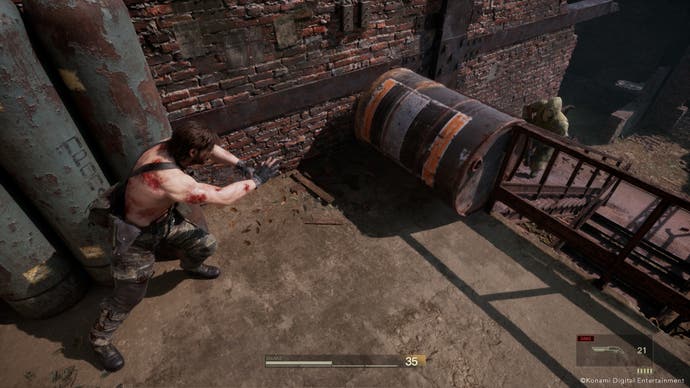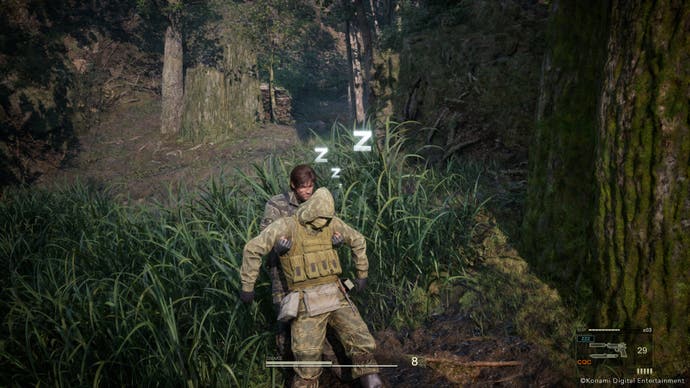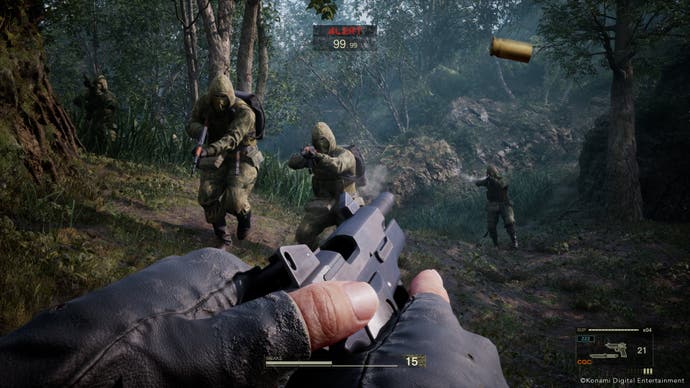Metal Gear Solid Delta: Snake Eater is a doggedly faithful remake - but new controls have new consequences
"Our goal was to recreate it as-is."
How far is too far for a remake - and how safe is too safe? For Metal Gear Solid Delta: Snake Eater, a sumptuous Unreal Engine 5 remake of a 2004 classic, finding a winning answer to this question has led to a great many careful choices at Konami. The combat and camera are updated, the visuals are starkly improved, and yet the original's DNA still courses through the experience. Perhaps even more-so than another ongoing remake effort - Silent Hill 2, as handled by Bloober team - this project rather prefers a more literal approach. In playing its opening 90 minutes, covering the Virtuous Mission prologue, it's also clear that a deep respect for Hideo Kojima's 2004 original steers Delta towards a stricter 1:1 recreation than you might expect.
Let's start with the cut-scenes. Every shot during Delta's opening sequence is a perfect match for the PlayStation 2 original's, right down to the timing of each camera cut. It makes a clear statement of intent early on: a military plane courses through the night sky as the words "based on Metal Gear Solid 3" flash across - which rings as an understatement in this case. The entire original team is credited en route, and everything is exactly as a long-term fan might remember. Between Snake lifting his cigar as he broods in the plane's hangar, to the way a bullet shell - stylishly - rolls past the foreground during a later showdown with Revolver Ocelot, it all translates exactly.
UE5 does the heavy lifting now, of course, where Konami takes point in updating its character models and environments - lighting and shading them within a new renderer. Still, all of this wraps around an existing framework of crash zooms and whip-pans set in place by Kojima's team 20 years ago. The game's producer, Noriaki Okamura, explains his team's approach:
"From the start it was not our intention to do the same as other remake titles, where [they] add in or change the core gameplay. Our goal was to recreate it as-is, so people can keep its nostalgic essence, and play it as they remember," he explains. "And so, the main focus for what we did change for the remake was to update the graphics and also modernise some of the controls."
"Regarding the cut-scenes we are actually using the original camera and cut-scene data. We re-did the visuals on top of this. What we did do from scratch were the facial animations, because now that we updated the character models the original animation didn't match up with the lip sync."
The updated character models are a marvel to see in motion, and it's a relief that Delta's added facial animations actually blend in well. It's a well-judged move from Okamura and his team, I think, given that the simple lip flap motions of the PS2 original - as effective as they were for its day - are so often put in close-up. For the remake, these moments also put its upgrades into clear view. We see the cracked paint, dirt and sweat streaking across the pores on Snake's face. New creases are added to The Boss' brow, crisply lit by the dusk sun during a (still very long) bridge exchange. The camera even orbits close enough to catch the fine stitching of his fatigues, while the felt texture on Ocelot's cap takes on a fresh, photo-realistic quality. Looking more broadly at the jungle itself, every divot in tree bark, the hard, textured skin of the crocodiles, and the juts to Rassvet's red brickwork scream out the extent of the improvement.
Also - yes - MGS3's use of occasional real-world footage returns. The remake deploys the same archived recordings as the original to set up its paranoia-fuelled, Cold War backdrop. A montage of Robert F. Kennedy speeches and military marches present in sepia, now at a higher resolution here. Also, in step with its video treatment, codec calls now play out with an audible boost to encoding quality during the PS5 build on show.
On that point, a few words on the state of the PS5 version right now. The early build I played offered a slick, snappy 4K menu with the provision of two graphics modes: a performance mode (which openly states it's using a dynamic 1080p to 4K resolution, targeting 60 frames per second) and a visuals mode (dynamic 1440p to 4K at 30fps).
I love the transparency here. Only the 30fps visuals mode was available for the demo, however, though this thankfully proved to be a perfectly stable experience, barring one noticeable drop during a camera cross fade. No ray tracing features are included, according to Okamura, but it'll be interesting to see if Unreal Engine 5's Lumen tech is deployed in any form for the final release, as a partial step towards RTGI or reflections. Finally, for those inclined to tinker further, we also appear to be getting a motion blur setting that goes up to ultra on PS5, plus a depth of field toggle.




A new 'modern' control setup marks the remake's biggest, and possibly most contentious change meanwhile. It's a revamp that has Delta play much closer, in effect, to the likes of Metal Gear Solid 5 where the L2 and R2 buttons are on task for aiming and shooting, while holding the d-pad left or right raises the item and weapon menus. These bindings are sensibly rejigged to suit a modern audience, but crucially it also makes Snake more proficient as a one-man-army this time around.
The upshot is this: moving and aiming is now possible simultaneously, an added freedom (also seen in the 3DS edition, to be fair) that Konami aims to counter-balance in Delta with updated enemy behaviour. A new balance must be struck in its difficulty, but to be frank, it does appear to cut into the original's stealth-focused challenge. Ultimately, Snake's extra manoeuvrability now tends to encourage a more hurried, Rambo-style method in sweeping through each portion of the jungle. There's no question in my mind, it gets the job done a lot faster - whereas a promised alternative, legacy control option (not available to play in this build) should offer the more honest Metal Gear experience.
So much of the original AI's behaviour still remains despite this. The idiosyncrasies of Metal Gear are welcome nonetheless: enemies still strafe suddenly, in a tauntingly brisk left-right motion, only just as you line them up in your crosshairs. They still go flying mid-air, comically, after colliding with a rolling barrel. They still have the same classic 'passing out' animation after being tranquilised, snapping in midway through their sentry route. Metal Gear has often found its fun in pairing dense, military rhetoric with these moments of slapstick, of emergent silliness in its mechanics.

All of this stays, and even the Kerotan toy collectibles make a return. Indeed, every inch of Snake Eater's jungles are recreated to a tee - to such an extent that there isn't any intention to remove the loading screens between each area. I can confirm, in speaking with Okamura, that even later boss encounters, like The End, will still play out across multiple forest areas partitioned by a fade to black. In many ways, the parameters of Metal Gear's levels are a core part of the series' game design, and so this stays for a doggedly faithful remake.
Besides a loose 2024 timeframe, there's no specific release date for Metal Gear Solid Delta as yet. The outlook is positive though. While I do have reservations about the game's revised balance - especially looking at its marriage of new control mechanics with tight, PS2-era levels - it's still the most exciting project to come out of Konami in many years. The visual upgrades run deep, and I'll be curious to see if its promised 60fps mode runs well, too. Helpfully, the blueprint laid out by Hideo Kojima and his team is a strong one. So much of its appeal, its setting and cut-scene direction, still shine brightly today, and the remake has a genuine shot at introducing a classic to a fresh new audience.







